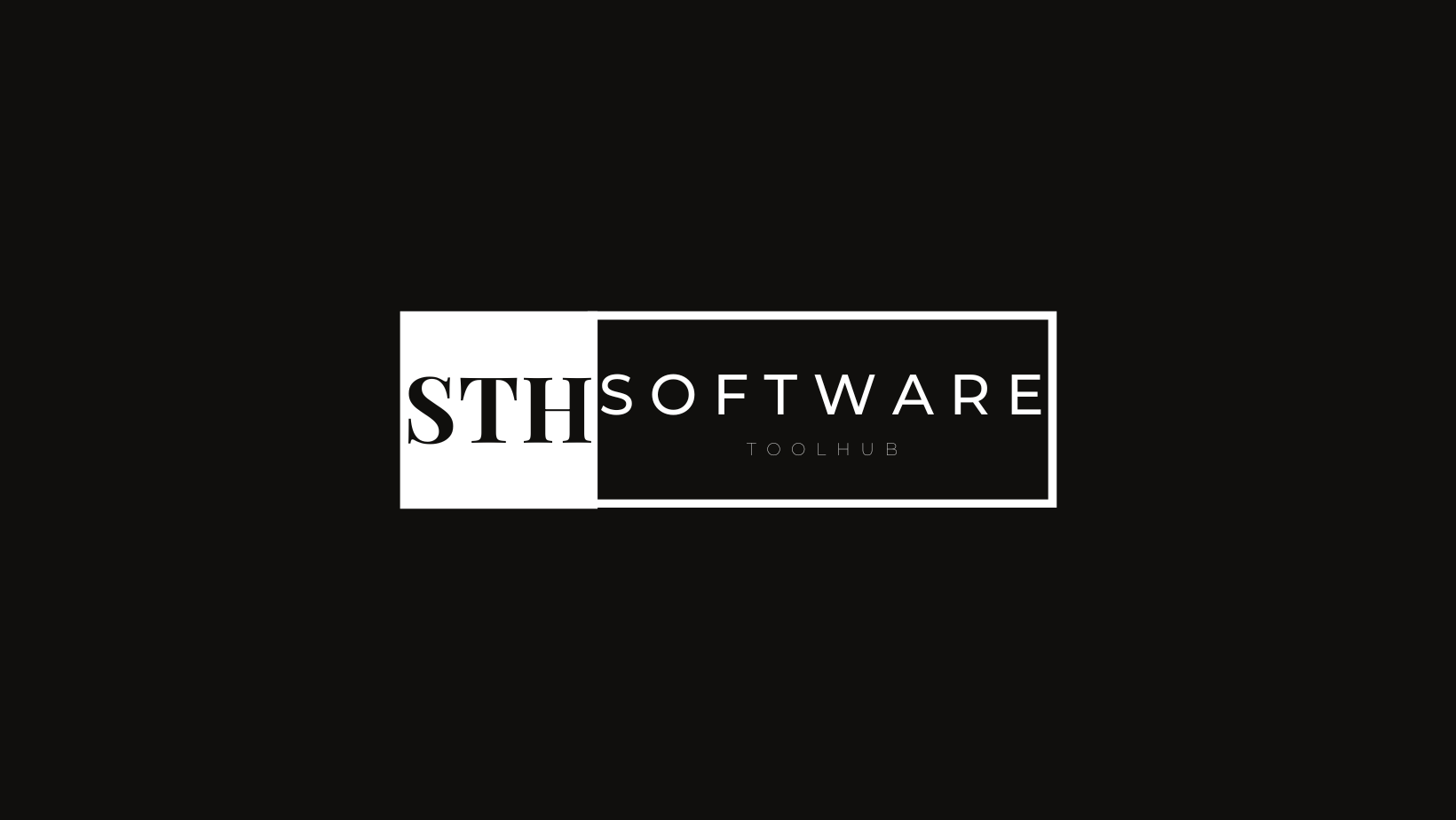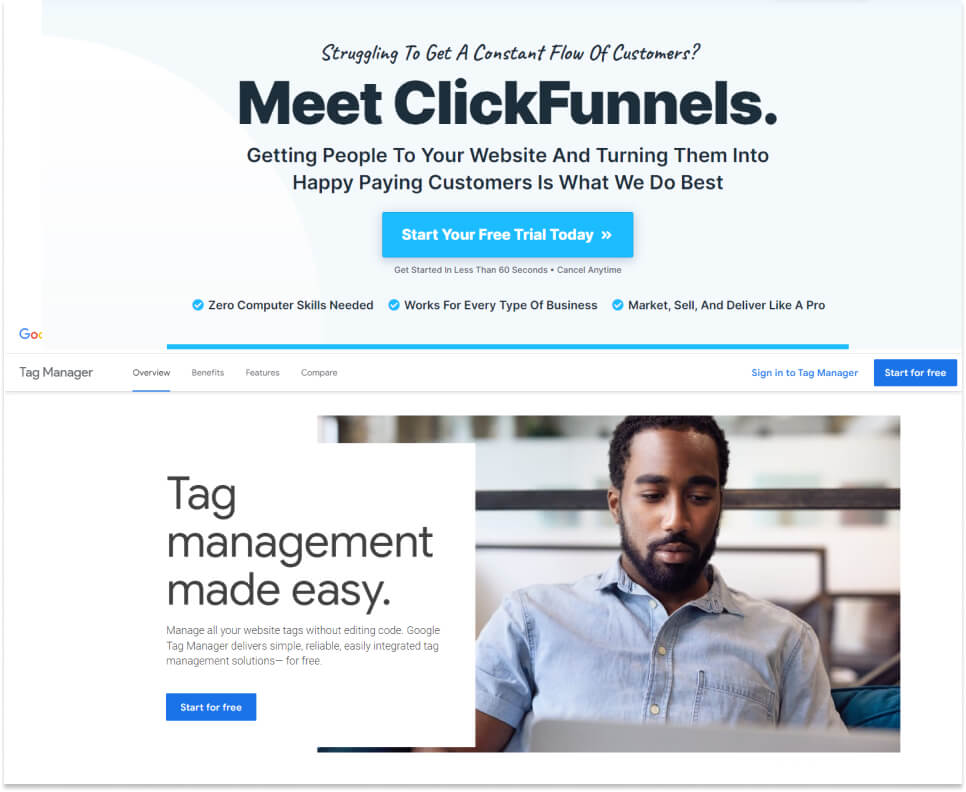The power of ClickFunnels Google tag manager is second to none. In the ever-evolving landscape of online marketing, maintaining a competitive edge demands more than just traditional strategies. It necessitates a strategic fusion of state-of-the-art tools and a resilient digital framework. It is within this dynamic environment that the symbiotic relationship between ClickFunnels and Google Tag Manager emerges as not just advantageous but truly indispensable.
The essence of successful digital marketing lies in the ability to adapt, innovate, and harness technologies that enhance efficiency and effectiveness. ClickFunnels, renowned for its prowess in crafting high-converting sales funnels, joins forces with Google Tag Manager, a tool designed to simplify and amplify the tracking and analytics process. Together, they form a formidable alliance that empowers businesses to navigate the complexities of the online landscape with finesse.
In this exhaustive guide, our mission is to plunge into the intricate details of how this dynamic duo, ClickFunnels and Google Tag Manager, can be harnessed to unlock the full potential of an online presence. We will unravel the layers of functionality, explore seamless integration processes, and illuminate the path to optimizing every facet of digital marketing through these two technological powerhouses. Join us as we embark on a journey to revolutionize your online strategy and elevate your brand to unprecedented heights.
Table of Contents
Key Takeaways : ClickFunnels Google Tag Manager
- Strategic Integration for Success: The integration of ClickFunnels Google Tag Manager isn’t just a technical merger; it’s a strategic move to enhance the efficiency and effectiveness of your digital marketing efforts.
- Data-Driven Decision Making: Google Tag Manager provides a robust data foundation for ClickFunnels, allowing businesses to make informed decisions. This data-driven approach empowers marketers to refine strategies, identify bottlenecks, and optimize user journeys for maximum impact.
- Holistic Funnel Optimization: ClickFunnels, when coupled with GTM, facilitates a comprehensive optimization process. From identifying user friction points to refining the entire funnel flow, businesses can tailor their digital journeys to enhance user experiences and increase conversions.
- Real-Time Adaptability: Leveraging GTM data enables real-time adjustments within ClickFunnels. Whether it’s adapting content based on user behavior or implementing dynamic experiences, businesses can stay agile, ensuring their funnels are responsive to evolving user preferences.
- Personalization for Engagement: GTM empowers ClickFunnels to go beyond generic interactions. By implementing personalized content based on user behavior, businesses can enhance engagement, fostering a deeper connection with their audience and increasing the likelihood of conversions.
- Competitive Edge in the Digital Landscape: The amalgamation of ClickFunnels Google Tag Manager provides businesses with a competitive edge. It’s not just about keeping up with digital trends; it’s about setting them. This integration positions businesses as pioneers in the dynamic and highly competitive digital marketing realm.
- Continuous Adaptation and Innovation: The journey doesn’t end with integration; it’s a continuous cycle of adaptation and innovation. ClickFunnels Google Tag Manager aren’t tools for the present; they are guides into the future of digital marketing. Embracing this integration is a strategic decision to navigate the evolving digital landscape with foresight and agility.
- Elevated Online Presence and Conversions: Businesses that integrate ClickFunnels Google Tag Manager witness a transformative elevation of their online presence. The result is not just increased traffic but a measurable uptick in conversions and revenue, solidifying their position as leaders in the digital space.
Understanding ClickFunnels
What Sets ClickFunnels Apart
At the core of digital innovation stands ClickFunnels, a powerhouse in the realm of online marketing. Its distinction lies in being more than just a sales funnel builder; it’s a versatile toolkit empowering businesses to craft compelling narratives that convert visitors into loyal customers seamlessly.
ClickFunnels stands out through its:
1. Versatility in Funnel Building
ClickFunnels isn’t limited to just creating landing pages. It offers a comprehensive suite for developing high-converting sales pages and entire sales funnels. This versatility ensures that businesses, irrespective of their scale or niche, can leverage its capabilities to drive conversions.
2. User-Friendly Interface
An intuitive drag-and-drop interface lies at the heart of ClickFunnels. Entrepreneurs and marketers, whether tech-savvy or not, find themselves navigating the platform with ease. This accessibility transforms the daunting task of funnel creation into a user-friendly experience.
3. Pre-Designed Templates
ClickFunnels doesn’t just stop at functionality; it also addresses the aesthetics. The platform provides a plethora of pre-designed templates, offering a head start in creating visually appealing and effective sales funnels. This feature accelerates the entire process, saving time and resources.
The Role of ClickFunnels in Digital Marketing
ClickFunnels transcends the conventional boundaries of website design; it’s a strategic partner in guiding visitors through a purposeful sales journey. Here’s how ClickFunnels becomes an integral player in the digital marketing landscape:
1. Holistic Approach to Sales
ClickFunnels is not merely about creating a sales page; it’s about orchestrating a holistic sales experience. From initial lead generation to the final conversion, every stage is meticulously designed. This comprehensive approach ensures that no potential lead falls through the cracks, maximizing the chances of conversion.
2. Streamlined Sales Processes
The features embedded within ClickFunnels act as a well-oiled machine, streamlining the entire sales process. Automation, one-click upsells, and strategically placed calls-to-action work in tandem to remove friction from the buyer’s journey. The result? Increased conversions and a boost in overall revenue.
3. Data-Driven Decision Making
ClickFunnels doesn’t operate in isolation; it thrives on data. The platform provides robust analytics, offering insights into user behavior at every touchpoint. This data-driven approach allows marketers to make informed decisions, tweaking and optimizing the funnel for maximum efficiency.
In essence, ClickFunnels is not just a tool; it’s a catalyst for transforming digital marketing strategies, ensuring businesses not only survive but thrive in the competitive online landscape.
The Power of Google Tag Manager
Simplifying Tracking with GTM
In the intricate landscape of online analytics, Google Tag Manager (GTM) emerges as a revolutionary force, reshaping the way we implement and manage tracking codes. This centralized platform transcends conventional tracking methods, offering marketers a streamlined and agile solution for deploying and updating tags seamlessly. What sets GTM apart is its ability to empower marketers without necessitating constant developer intervention.
Key Advantages of GTM
- Centralized Control : GTM acts as a command center for all your tracking needs. Instead of scattering code implementations across multiple pages, GTM consolidates everything in one user-friendly interface, enhancing efficiency and reducing the likelihood of errors.
- Dynamic Tag Deployment : The agility of GTM lies in its dynamic tag deployment capabilities. Marketers can add, edit, or remove tags without delving into the website’s source code, providing unparalleled flexibility and speed in adapting to evolving tracking requirements.
- Version Control : GTM introduces version control, allowing marketers to roll back to previous configurations if needed. This feature adds a layer of security, ensuring that changes can be reverted if unexpected issues arise.
ClickFunnels Google Tag Manager Integration
Setting the Foundation
Before embarking on the seamless integration journey between ClickFunnels Google Tag Manager , it’s crucial to establish a solid foundation. This involves ensuring administrative access to both your ClickFunnels and GTM accounts. This foundational step not only expedites the setup process but also acts as a preventive measure, eliminating potential roadblocks that may hinder the integration process.
Ensuring Administrative Access
Verify that you possess administrative privileges for both your ClickFunnels Google Tag Manager accounts. This access ensures that you have the necessary permissions to implement changes and configurations seamlessly. Without this foundational access, the integration process may encounter unnecessary delays.
Step-by-Step Integration Guide
Now that the foundation is laid, let’s delve into the step-by-step guide for integrating ClickFunnels Google Tag Manager.
1. Create a GTM Account
Initiating the Process
Begin the integration journey by creating a Google Tag Manager account if you haven’t already. Navigate to the GTM website and initiate the account creation process. This typically involves providing essential information about your business and website.
Obtain GTM Container Code
Once the account setup is complete, you’ll be furnished with a unique GTM container code. This code is the linchpin of the integration process, serving as the bridge between GTM and ClickFunnels.
2. Implement GTM Container Code in ClickFunnels
Navigate to ClickFunnels Settings
In your ClickFunnels account, navigate to the settings section corresponding to the specific funnel or page you intend to track. Look for the tracking settings, usually located within the advanced configuration options.
Paste GTM Container Code
Insert the GTM container code into the designated section within ClickFunnels. This pivotal step establishes the connection between your ClickFunnels pages and the tracking prowess of GTM. Save the changes to solidify the integration.
3. Define Triggers and Tags
Precision in Tracking
Within the Google Tag Manager interface, commence the setup of triggers and tags tailored to capture specific interactions within your ClickFunnels. Whether it’s monitoring form submissions, tracking button clicks, or registering page views, meticulous tracking is the key to comprehensive data collection.
4. Test the Integration
Thorough Pre-Deployment Testing
Before unveiling your funnel to the online audience, undertake a comprehensive testing phase. This involves navigating through the funnel, interacting with different elements, and validating whether the configured triggers and tags function as intended. Testing ensures a smooth and error-free integration, laying the groundwork for accurate data collection once the funnel goes live.
By meticulously following these steps, you pave the way for a seamless ClickFunnels Google Tag Manager integration, establishing a robust infrastructure for data-driven decision-making in your digital marketing endeavors.
Optimizing ClickFunnels Google tag manager Data
Data-Driven Decision Making
Armed with the wealth of data meticulously collected through Google Tag Manager (GTM), the optimization journey for your ClickFunnels strategy takes on a transformative and data-driven approach. In this section, we explore how leveraging GTM data can become the cornerstone of refining your ClickFunnels for optimal performance.
Identifying Bottlenecks
Analyzing User Interactions
GTM provides a granular view of user interactions within your ClickFunnels. Leverage this data to identify bottlenecks — those points where users may encounter friction or disengagement. Whether it’s a high bounce rate on a particular page or a drop-off in the middle of the funnel, the insights gained through GTM empower you to pinpoint and address these issues strategically.
Refining Funnel Flow
Armed with a nuanced understanding of user journeys, fine-tune the flow of your ClickFunnels. Optimize the sequence of pages, calls-to-action, and content delivery to ensure a seamless progression. GTM’s data becomes your compass, guiding you toward a user-centric funnel that maximizes engagement and minimizes friction.
Optimizing User Journeys
Tailoring Experiences
GTM’s data isn’t just about numbers; it’s about the stories they tell. Dive deep into user journeys to understand how visitors navigate through your ClickFunnels. Identify patterns, preferences, and stumbling blocks. Armed with this knowledge, optimize user journeys by tailoring experiences to align with user expectations. This might involve restructuring content, adjusting navigation elements, or refining the messaging to resonate more effectively.
A/B Testing for Precision
Implement A/B testing strategies guided by GTM data. Test variations of pages, headlines, or calls-to-action to discern what resonates most with your audience. This iterative approach, driven by concrete data insights, ensures that optimization decisions are rooted in empirical evidence, leading to continuous improvements in ClickFunnels performance.
Personalization and Dynamic Content
Going beyond conventional approaches, GTM opens the door to a realm of personalized content strategies within your ClickFunnels. This section explores how you can harness the power of GTM for implementing dynamic and personalized content tailored to individual user behaviors.
Personalized Content Implementation
Understanding User Behavior
GTM’s ability to track user behavior provides a nuanced understanding of individual preferences. Leverage this insight to deliver personalized content experiences. Whether it’s tailoring product recommendations, showcasing content based on past interactions, or customizing calls-to-action, GTM enables a level of personalization that resonates with your audience on a one-to-one level.
Segmenting Audiences
Utilize GTM data to segment your audience based on their behavior and characteristics. Create dynamic content that caters specifically to each segment. For instance, if GTM indicates a segment of users consistently engages with a particular product category, dynamically showcase related products in subsequent interactions.
Dynamic User Experience Adjustment
Real-Time Adjustments
GTM’s real-time data allows for dynamic adjustments to the user experience. If a user exhibits interest in specific features or products, dynamically adjust the ClickFunnels experience to align with their preferences. This adaptability ensures that users encounter content and offers that resonate with their evolving interests throughout their journey.
Personalization for Enhanced Engagement
Personalized content isn’t just about customization; it’s about enhancing engagement. By delivering content and experiences tailored to individual preferences, GTM enables ClickFunnels to transcend generic interactions, fostering a deeper connection with users and increasing the likelihood of conversion.
In essence, the integration of GTM data into ClickFunnels propels optimization beyond intuition, making it a precision-driven exercise based on real user behavior. Whether it’s refining the overall funnel flow or implementing dynamic content strategies, GTM becomes the linchpin for elevating ClickFunnels performance and driving sustained success in the ever-evolving digital landscape.
Pros and Cons of ClickFunnels Google Tag Manager Integration
Pros:
- Data-Driven Decision Making:
- Integration provides valuable insights through Google Tag Manager, enabling data-driven decisions for optimizing ClickFunnels.
- Holistic Funnel Optimization:
- Businesses can identify and address bottlenecks, refine user journeys, and optimize the entire funnel for better performance.
- Real-Time Adaptability:
- The integration allows real-time adjustments based on user behavior, ensuring a responsive and adaptive ClickFunnels experience.
- Personalization Opportunities:
- Google Tag Manager facilitates personalized content implementation, enhancing engagement and connection with the audience.
- Competitive Edge:
- Businesses gain a competitive advantage by staying agile, leveraging data insights, and setting trends in the dynamic digital marketing landscape.
- Enhanced Conversions:
- The integrated approach contributes to increased conversions by refining strategies, understanding user behavior, and delivering tailored experiences.
- Versatility in Funnel Building:
- ClickFunnels’ versatile funnel-building capabilities complemented by GTM’s insights offer a comprehensive solution for digital marketing.
- Efficient Tracking with GTM:
- Google Tag Manager simplifies tracking code implementation, reducing reliance on developers and streamlining the tracking process.
Cons:
- Learning Curve:
- The integration process may pose a learning curve for those unfamiliar with ClickFunnels Google Tag Manager, potentially requiring additional training.
- Initial Setup Complexity:
- The initial setup, including creating a GTM account and implementing the container code in ClickFunnels, may be complex for beginners.
- Continuous Monitoring Required:
- Ongoing monitoring and maintenance are necessary to adapt to evolving user behaviors and ensure the integration’s continued effectiveness.
- Dependency on Accurate Data:
- The success of the integration relies heavily on accurate data collection; any discrepancies may lead to misinformed decisions.
- Potential for Technical Issues:
- As with any digital integration, there is a potential for technical issues that may require troubleshooting, especially during the initial setup phase.
- Resource Intensive:
- The integration process and ongoing optimization may require dedicated resources, both in terms of time and expertise.
- Limited to Digital Marketing Scope:
- The integration primarily focuses on digital marketing strategies and may not directly address broader business operations.
- Need for Regular Updates:
- Staying informed about updates to ClickFunnels and Google Tag Manager is essential for optimal performance, requiring ongoing attention and adaptation.
Conclusion
In wrapping up this comprehensive guide, the undeniable truth surfaces – the fusion of ClickFunnels Google Tag Manager heralds a paradigm shift in the digital marketing arena. The seamless integration of these two formidable tools transcends mere utility; it becomes a game-changer, a strategic imperative for businesses striving not just to survive but to thrive in the fiercely competitive digital landscape
Frequently Asked Questions (FAQ) – ClickFunnels Google Tag Manager
Q1: What is ClickFunnels, and how does it benefit my business?
A1: ClickFunnels is a versatile sales funnel builder designed to empower businesses in creating high-converting landing pages, sales pages, and complete sales funnels. It streamlines the online sales process with its user-friendly interface, pre-designed templates, and a focus on guiding visitors through a strategic sales journey.
Q2: What is Google Tag Manager (GTM), and how does it complement ClickFunnels?
A2: Google Tag Manager is a centralized platform that revolutionizes the implementation and management of tracking codes. When integrated with ClickFunnels, GTM provides valuable insights into user behavior, enabling precise tracking, monitoring conversions, and facilitating data-driven decision-making.
Q3: Why should I integrate ClickFunnels Google Tag Manager?
A3: The integration of ClickFunnels Google Tag Manager offers a strategic advantage. It allows businesses to harness the power of data-driven insights, optimize user journeys, identify bottlenecks, and adapt the funnel in real-time. This integration ensures a holistic approach to digital marketing, enhancing online presence and driving conversions.
Q4: How do I initiate the integration process between ClickFunnels Google Tag Manager?
A4: To initiate the integration:
- Ensure administrative access to both your ClickFunnels Google Tag Manager accounts.
- Create a GTM account if you don’t have one, obtain the GTM container code.
- Implement the GTM container code in the ClickFunnels tracking settings.
- Define triggers and tags within GTM to capture specific user interactions.
- Thoroughly test the integration before deploying it live to ensure accurate data collection.
Q5: What kind of insights can I gain from GTM data within ClickFunnels?
A5: GTM data provides granular insights into user behavior, helping businesses identify bottlenecks in the funnel, optimize user journeys, and refine elements contributing to higher conversion rates. The data-driven approach ensures informed decision-making for enhancing the overall performance of ClickFunnels.
Q6: How does GTM enable personalization within ClickFunnels?
A6: Google Tag Manager enables personalization by tracking user behavior. Businesses can use this data to implement personalized content experiences within ClickFunnels. Whether tailoring product recommendations or dynamically adjusting the user experience, GTM’s capabilities enhance engagement through personalized interactions.
Q7: Is the integration a one-time setup, or does it require ongoing maintenance?
A7: While the initial setup involves creating the integration between ClickFunnels and GTM, it’s essential to recognize that digital landscapes evolve. Regular monitoring, testing, and adjustments may be needed to adapt to changing user behaviors and optimize the performance of your ClickFunnels over time.
Q8: What competitive advantages does the integration provide in the digital marketing landscape?
A8: The integration of ClickFunnels Google Tag Manager equips businesses with a competitive edge by facilitating data-driven decision-making, real-time adaptability, and personalized user experiences. This strategic advantage positions businesses at the forefront of the dynamic and highly competitive digital marketing realm.
Q9: Can I revert changes made through GTM if needed?
A9: Yes, GTM provides version control, allowing businesses to roll back to previous configurations if necessary. This feature adds a layer of security, ensuring that changes can be reverted in case unexpected issues arise during the integration process.
Q10: How can businesses ensure they are leveraging the full potential of ClickFunnels Google Tag M anager integration?
A10: To leverage the full potential, businesses should not only follow the initial integration steps but also continuously analyze GTM data, conduct A/B testing, and stay informed about updates to both ClickFunnels Google Tag Manager functionalities. Regularly refining strategies based on insights ensures ongoing optimization and maximizes the benefits of the integrated approach.



